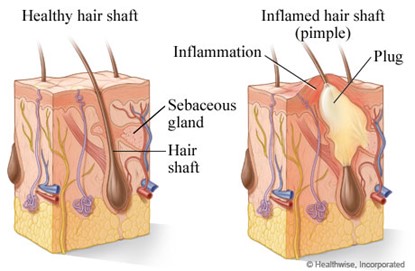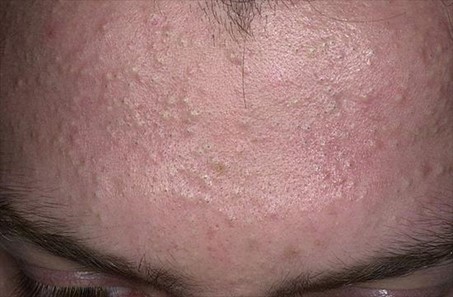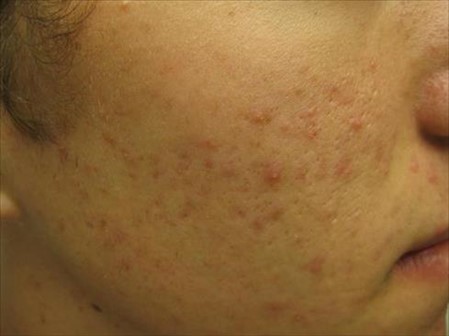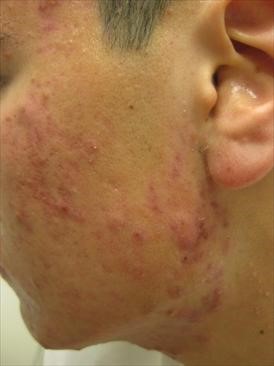Acne
What is Acne?
Acne is a skin condition that occurs when hair follicles become clogged with oil (sebum), dead skin cells, and sometimes bacteria. This blockage can lead to the formation of pimples, blackheads, whiteheads, cysts, or other blemishes on the skin. While acne is often associated with puberty and hormonal changes, it can affect individuals at any age.
Acne forms when several factors come into play:
- Excess Oil Production: Sebaceous glands in the skin produce oil (sebum) to keep the skin lubricated. Overproduction of sebum can clog hair follicles, leading to acne.
- Clogged Hair Follicles: When excess oil and dead skin cells accumulate, they can clog hair follicles, creating an environment where bacteria can thrive.
- Bacterial Growth: The bacteria, Cutibacterium acnes or C.acne, is naturally found on the skin but can multiply inside blocked follicles, causing inflammation, leading to pimples, cysts, or nodules.
- Hormonal Changes: Hormones, particularly androgens, increase during puberty, menstruation, pregnancy, or hormonal therapies, stimulating the sebaceous glands to produce more oil.
- Inflammation: As bacteria grow and the body’s immune system responds, inflammation occurs, leading to redness, swelling, and the development of various types of acne lesions.

Types of Acne
Acne varies in severity and appearance. Understanding the different types of acne can help identify the most effective treatment options:
Comedonal Acne

Comedonal acne is characterized by the presence of comedones—either blackheads (open comedones) or whiteheads (closed comedones). These occur when hair follicles are blocked by excess oil and dead skin cells. Blackheads appear as dark spots on the skin due to oxidized melanin, while whiteheads are small, flesh-colored bumps.
Inflammatory Acne

Inflammatory acne develops when our own immune system reacts to the bacteria in the clogged pores, causing the follicles to become swollen and inflamed. This type of acne includes:
- Pimples (papules): Small, pink to red, possibly painful bumps.
- Pustules: Yellow to white bumps filled with pus.
- Nodules: Larger, painful lumps beneath the skin’s surface, which can take weeks to heal and can leave scars on healing.
- Cysts: Deeper, sometimes painful, fluid-filled lumps under the skin that can leave scars.
Cystic Acne

Cystic acne is a severe form of inflammatory acne. It can have comedones, nodules and cysts that can be painful and often leave scars. Timely treatment of cystic acne with topical and oral treatments is recommended to minimize scarring. Discoloration caused by acne can be treated with chemical peels (VI Peel) and topical products (Obagi treatment system). The redness and scarring caused by cystic acne can be treated very well with laser treatments (see treatment section below).
Hormonal Acne
Hormonal acne typically appears as pimples or nodules along the jawline, chin, and neck and is commonly seen in teenagers and adults, especially women in their 30’s and 40’s. It often flares up around menstruation, pregnancy, or periods of hormonal fluctuation (such as the use of birth control or hormone replacement therapy).
Acne Treatments
Kaiser Permanente Dermatologists have developed many effective and economical treatment options for the different types of acne that you might be dealing with. Topical treatments are applied directly to the skin and can be effective for mild to moderate acne. Some of the most common options include:
- Benzoyl Peroxide: This ingredient works by killing acne-causing bacteria and reducing inflammation. It is commonly found in gels, creams, and cleansers. Using this product is essential to reduce the risk of bacterial resistance to antibiotics.
- Salicylic Acid: A beta hydroxy acid (BHA) that exfoliates the skin and helps to unclog pores, salicylic acid is effective for treating blackheads and whiteheads.
- Retinoids (e.g., tretinoin, adapalene): Retinoids are derived from vitamin A and help prevent clogged pores by encouraging skin cell turnover. They are effective for treating blackheads, whiteheads, and inflamed acne.
- Antibiotics (topical): Antibiotic creams or gels, such as clindamycin, reduce inflammation and bacterial growth on the skin.
It is important to realize that most of the above products can be irritating to the skin and the using the gentle formulation of these products can make them more tolerable. Click here for gentle and tolerable acne products and regimens recommended by our Kaiser Permanente dermatologists.
A chemical peel involves applying a chemical solution to the skin, which exfoliates the top layer and helps unclog pores. This treatment can improve the appearance of acne and reduce discoloration, especially for those with superficial acne.
Laser Therapy
Laser treatments, such as vascular lasers, IPL and non-ablative fractional (Fraxel) and ablative fractional (Co2) lasers can target the redness and scarring caused by acne. Vascular lasers like Vbeam Perfecta are especially useful for reducing the redness and inflammation of active acne. The Fraxel and Co2 lasers are useful to improve the scarring from acne.
Microneedling
Microneedling involves tiny needles that create micro-injuries in the skin, stimulating collagen production and improving skin texture. It is an effective treatment for very superficial acne scars. It is usually done as a series of 4 treatments.
Oral Medications
For moderate to severe acne, prescription medications may be helpful. Talk to your primary care physician or if you are a Kaiser Permanente member, consider using one of our online acne visits (e-visits) for evaluation of your acne.
- Oral Antibiotics (e.g., doxycycline, minocycline): These antibiotics reduce inflammation and bacteria, making them useful for treating inflammatory acne.
- Oral Contraceptives: Certain birth control pills regulate hormonal fluctuations, helping reduce acne caused by hormonal changes in women.
- Oral Retinoids (e.g., isotretinoin): Isotretinoin (commonly known as Accutane) is one of the most effective treatments for severe cystic acne. It works by reducing sebum production, preventing clogged pores, and decreasing inflammation. However, it requires careful monitoring due to potential side effects.
Click here to find Kaiser Permanente cosmetic providers near you.
